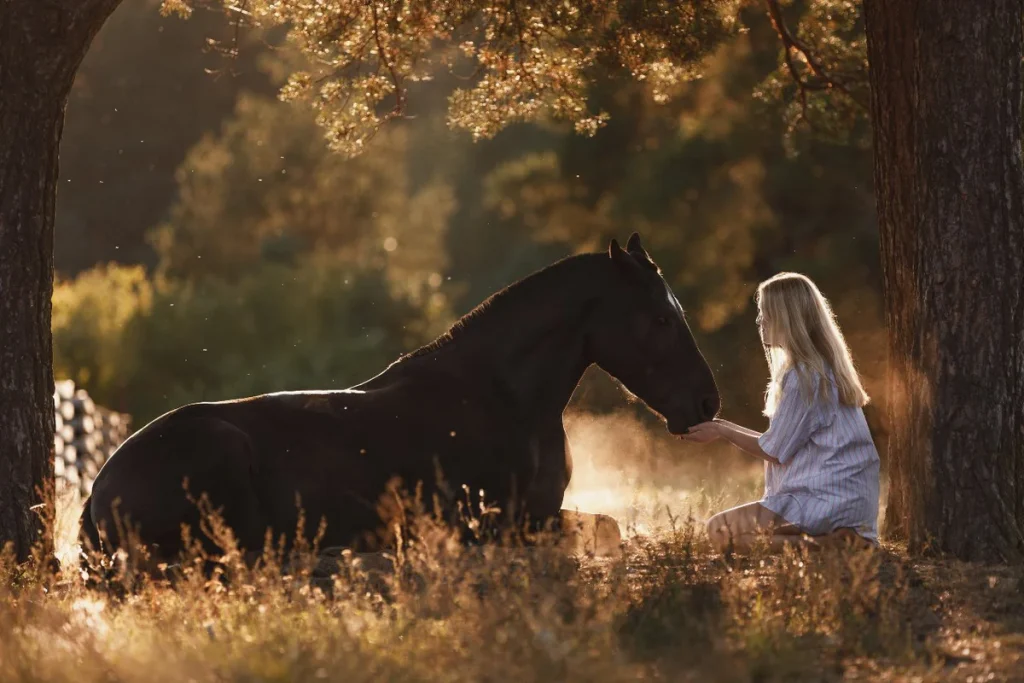- Understand the nuances of equine body language to communicate effectively with horses.
- Recognize the meaning behind different horse behaviors and postures.
- Learn how to read equine facial expressions, ear positions, and tail movements.
- Master the signs of equine comfort, stress, aggression, and submission.
- Explore techniques to enhance bonding and training through body language.
- Appreciate the importance of body language in horse-human relationships.
Communication with horses transcends spoken language, relying deeply on the nuanced dance of body language. Grasping the subtle art of equine communication is a journey into the heart of these magnificent creatures, offering insights into their minds and emotions. The body language of horses is a complex system of non-verbal cues that, when understood, can unlock a whole new world of interspecies connection.
To build a relationship that rests on the pillars of trust and comprehension, we must become fluent in the visual vocabulary horses use. Their every stance, movement, and expression is a word in a silent dialogue. By learning this language, we develop the skills necessary to understand and influence their behavior positively.
> READ MORE:
- How Do You Know If a Horse Likes You?
- Unlock the Signs: Master How to Tell If a Horse Is Uncomfortable with You
Contents
The Basics of Equine Body Language
Horses communicate their emotions and intentions through their body posture, ear and eye movements, and tail swishing. Just like humans, horses use body language instinctively to express themselves, with each gesture carrying meaning. To start mastering the body language of horses, observe their behavior in different scenarios – from relaxed grazing in a field to interactions with other horses and humans.
Facial Expressions and Ear Positions
A horse’s face is expressive, with eyes and ears that are highly indicative of mood and attention. Ears pricked forward indicate curiosity or alertness, while pinned back ears can signal irritation or aggression. Soft eyes and a relaxed jaw suggest a content and calm horse, whereas wide eyes and flared nostrils often denote fear or excitement.
Posture and Movement
The way a horse holds itself gives clues to its state of mind. A horse standing square and balanced is typically relaxed. In contrast, a horse shifting its weight or unable to stand still could be anxious or uncomfortable. Movements like head tossing or pawing can convey impatience or frustration. Observing these behaviors within context is key to interpret what a horse is communicating.
Tail Signals
The tail acts as an emotional barometer. A gently swinging tail may accompany a relaxed horse, while a clamped tail can be a sign of tension or fear. Vigorous tail swishing often indicates irritation, and understanding this can help to address a horse’s discomfort before it escalates.
Recognizing Signs of Comfort and Stress
In a serene environment, horses will exhibit a calm demeanor with slow, fluid movements and relaxed body language. Signs of stress, however, can manifest in various forms, including pacing, sweating, or refusing to eat. Recognizing these signs early allows for timely interventions to soothe the animal.
Bonding through Body Language
Relationships thrive on communication; thus, when interacting with horses, mirroring their positive body language can foster trust. Approaching a horse at an angle with a calm demeanor allows them to read friendly intentions. Consistent and gentle cues in training reinforce understanding and build a mutually respectful relationship.
The Role of Personal Space
Understanding a horse’s personal space and respecting it is crucial. Horses value their space and may communicate discomfort when it is invaded without proper introduction. Observing how horses interact with each other offers insights into how they might interpret human approaches to their space.
Conclusion
Mastering the body language of horses is not merely about issuing commands but about engaging in a dialogue. It’s a blend of observation, respect, and empathy that deepens the connection between equine and human. As we unlock the secrets of equine communication, we pave the way for profound relationships grounded in mutual understanding – a language beyond words.

